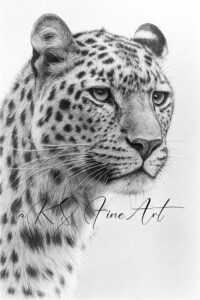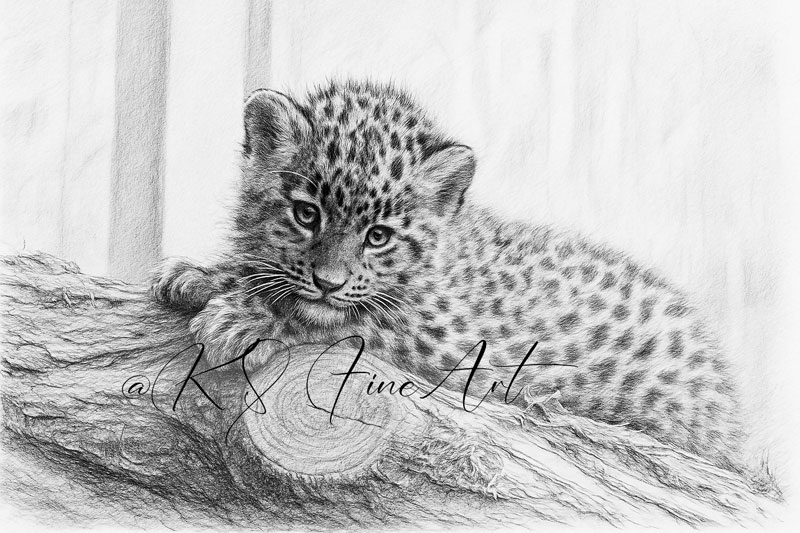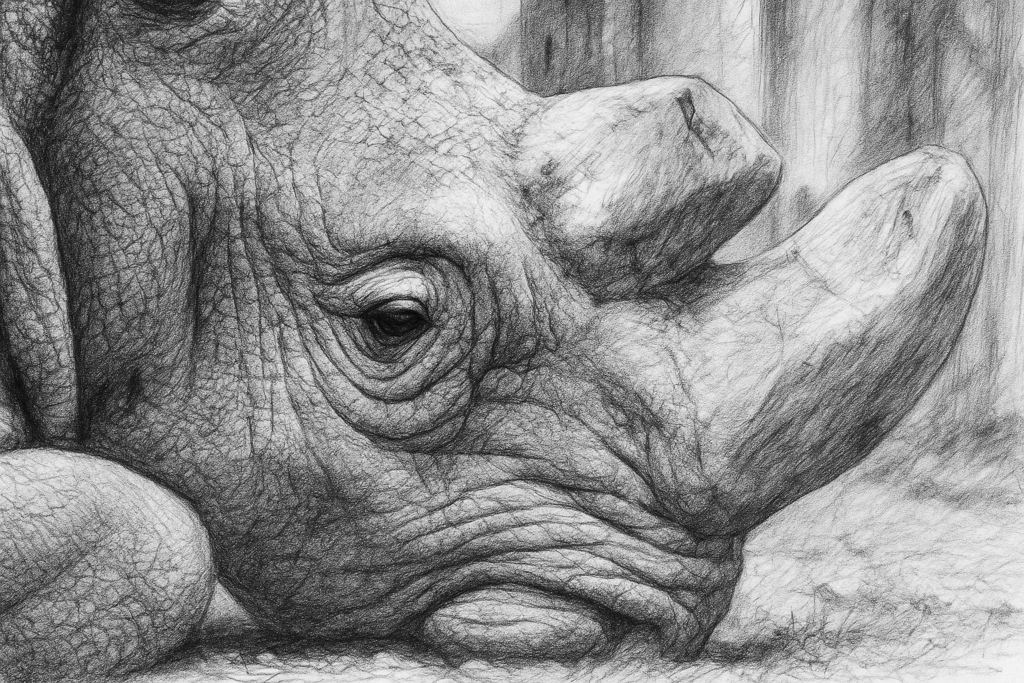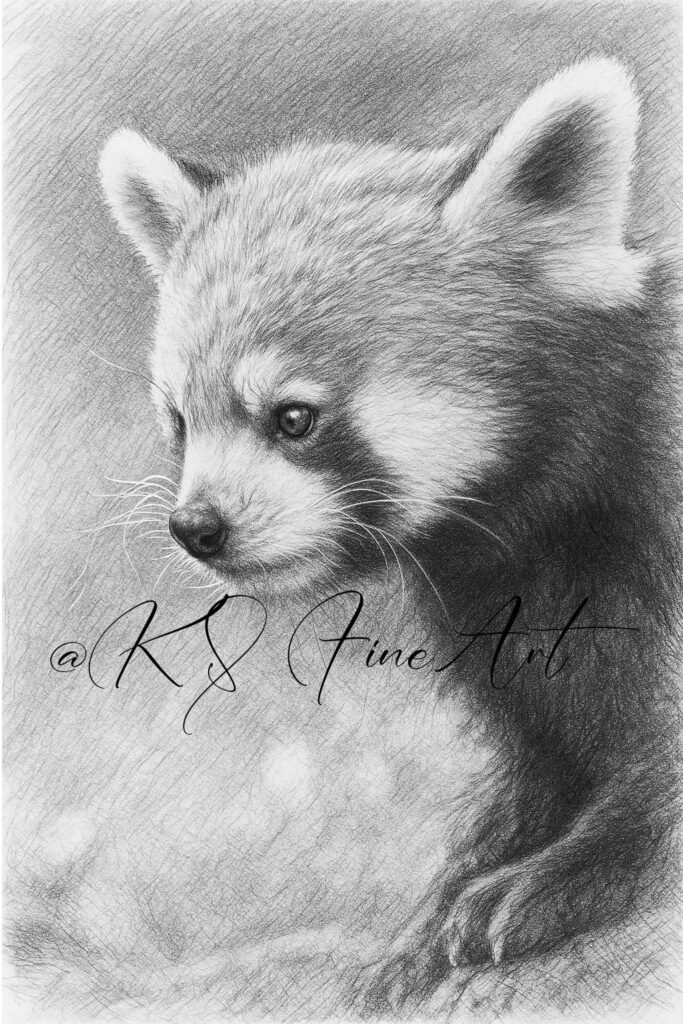With its thick, spotted coat and piercing gaze, the Amur leopard seems like a creature from another time. It is not only a symbol of grace and wildness—but sadly, also of urgent threat. Today, only a few dozen individuals remain in the wild. In this article, I want to introduce you not only to the fascinating world of this endangered big cat but also to give you a glimpse into my drawing process—since two of my current artworks are dedicated to this extraordinary animal.
A Life in Hiding
The Amur leopard (Panthera pardus orientalis) is a subspecies of leopard that inhabits the remote forests along the border between Russia and China. Unlike its tropical relatives, it is perfectly adapted to the cold climate: a particularly long, dense winter coat protects it from freezing temperatures down to -30°C (-22°F). Its fur is not only functional but breathtakingly beautiful — adorned with large, widely spaced rosettes on a golden background.
Amur leopards are solitary animals. They roam vast territories under the cover of dusk and darkness. Their prey mainly consists of deer, wild boar, and smaller mammals — hunting silently, patiently, and with great precision.
Critically Endangered
According to the IUCN (International Union for Conservation of Nature), the Amur leopard is classified as “critically endangered.” In the early 2000s, the population hit an all-time low — fewer than 40 individuals remained in the wild. The main causes are habitat loss due to deforestation, poaching, and a severely limited gene pool. Roads, settlements, and human activities fragment their habitat, making it difficult to sustain a stable population.
But there is hope: thanks to intense conservation efforts, strict monitoring, and the establishment of a national park in Russia (Land of the Leopard National Park), their numbers have slightly recovered. Current estimates suggest about 100 wild individuals — a small but meaningful step forward.
Art as a Voice for the Wild
I drew the Amur leopard for one simple reason: because it moved me deeply. Its majestic presence, almost mystical expression — and the thought that it could soon vanish entirely. When drawing, I try not only to portray the animal realistically but also to capture something of its soul.
The first drawing shows an adult Amur leopard in a three-quarter profile — poised, with delicate light playing on its fur and a watchful, expressive gaze.

The second drawing features an Amur leopard cub – curious, a little clumsy, with fluffy fur and big, wide eyes. It’s an image that not only reflects the vulnerability of this species but also sparks a sense of hope.

Both of these drawings were created with great patience and love for detail – layer by layer, hair by hair. Maybe these images can make a difference: raise awareness. Create connection. And awaken the desire to protect our wildlife.
Did You Know?
-
The Amur leopard is the most cold-resistant of all leopards – its winter coat is twice as long as that of other subspecies.
-
Its habitat is incredibly small – the main range of the wild population covers less than 5,000 km² – smaller than many German federal states.
-
It can leap up to 6 meters – an impressive skill that helps it hunt and overcome obstacles.
-
Every Amur leopard is unique – the pattern of its rosettes is as individual as a human fingerprint.
-
Despite its endangered status, it’s still largely unknown – while many people are familiar with lions and tigers, few have ever truly noticed the Amur leopard.
-
It faces a double threat – from genetic impoverishment in its small population and climate change, which continues to alter its habitat.
What We Can Do
Even though we may live far from the forests of the Far East, each of us can make a difference:
-
Raise awareness: Share the story of the Amur leopard and its struggle for survival.
-
Support organizations that work to protect endangered species (e.g. WWF, IFAW, Phoenix Fund).
-
Make sustainable choices: Protecting natural habitats often begins with everyday decisions.
-
Share art: Creative projects can draw attention and evoke emotion — a quiet, yet powerful contribution to conservation.
A Silent Appeal
The Amur leopard is not just an animal – it is a symbol of all we stand to lose. Its story is tragic, but not without hope. As long as there is life in the forests, as long as people care, speak out, draw, and protect — there is still a chance.
I hope these drawings and this post have given you a glimpse into the world of this fascinating big cat. And maybe, next time you look into its eyes, you’ll feel more than just admiration:
A sense of responsibility.
Coming Soon:
The next animal in the series – the red panda, also known as the “fire fox” or “cat bear,” once praised by Georges Cuvier in 1825 as “the most beautiful mammal on Earth.”
Also in the series:
Endangered Species – A Closer Look



